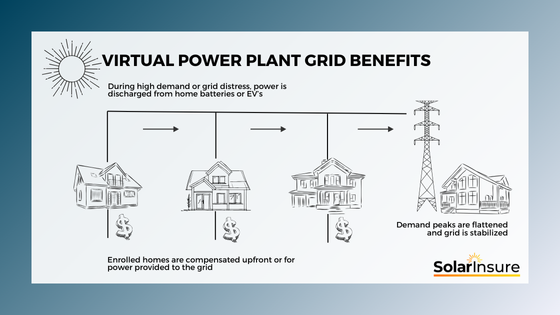
If you’re plugged into the clean energy industry it’s probably not news to you that battery storage adoption rates are increasing at rapid levels. Existing manufacturers are continuously making adjustments to their products and new players are entering the market every day with unique solutions, including battery-only functions.
You read that right, all of the functions of battery storage without being connected to a solar energy system. One utility in Vermont, Green Mountain Power, is approaching virtual power plants with a unique incentive.
Table of Contents
Virtual Power Plants (VPPs)
The concept of a virtual power plant isn’t new by any means, and we’ve seen a fair number of them out there. A virtual power plant (VPP) is a network of distributed energy sources, often paired with or consisting of batteries, that can work together to balance out energy supply and demand. Most commonly, we see VPPs sponsored by utility companies to respond to high grid demand.
Virtual power plants work like this: a network of energy storage (sources like solar, wind, and sometimes even electric vehicles) is connected via the internet to a central hub at the electric utility.
When the grid experiences times of extreme demand, they send out a signal to all the storage in their fleet to discharge power into the grid.
By doing this, the utility can curb the large spike in demand and potentially prevent outages. ISO-New England had a perfect example of demand shaving in June of this year. Collectively, the VPP assets shaved peak demand by 375 MW (megawatts), or the equivalent of adding a medium-sized natural gas power plant to the grid.
One of the most common times for large demand increases is during the summer on a warm evening. Homeowners are returning home from work, using appliances, and cranking up the AC to make the house comfortable for the evening. When power increases like that, peak rate structures start to apply and power gets more expensive for everyone. In areas with heavy population density and an older, weaker grid infrastructure, this spike in demand can also cause rolling blackouts.
It’s easy to think that a utility would only want to establish a VPP to benefit themselves, but in truth, VPPs benefit everyone using the grid. By allowing your battery storage to be discharged and fighting demand it can reduce the effects or on-peak rates on everyone. In times of grid distress, the power from everyone’s storage can help to keep the lights on.
How Does It Work for Homeowners?
Many utilities have programs set up to create their own virtual power plant. Check out your utility website, and you’ll likely see an incentive for battery storage. Electric utilities incentivize homeowners to participate in their programs by offering an upfront incentive to install batteries.
Homeowners get money for their battery installation, making it more cost-effective, and the utility gets access to the battery for discharging purposes. In some cases, the utility will specify that they are only able to discharge a certain amount of the battery at any given time, protecting the consumer from not being able to use their battery.

In others, payment depends on how much power homeowners send out to the grid during peak demand times. One such program exists in the San Diego area, you can read more about it here.
In the aforementioned San Diego incentive, homeowners get credit for the amount of power they send to the grid during a 2-hour peak window, as well as a flat $350/kWh payment upfront. A person installing a 13.5kWh Tesla Powerwall 2 or 3 would get a flat payment of $4,725 toward their battery installation.
Most of the programs that exist today require batteries to be installed with solar energy, and the programs require solar installation as part of the payment. One utility in Vermont is bucking the trend and offering an incentive to homeowners with or without solar.
Green Mountain Power Battery Storage Program

Green Mountain Power (GMP) is an electric utility in Vermont that serves a large portion of the state. They offer several rebates and programs for electric vehicles, home energy storage, and heating and cooling. Find their website here.
GMP offers two types of battery storage incentives, one of which is an incredibly unique option. Green Mountain Power has incentives for both a BYOD (Bring Your Own Device) and an Energy Storage Lease.
What makes the incentive unique is that Green Mountain Power is not requiring any solar installation to go along with these batteries; they’re designing the program for battery-only installs. By incentivizing battery-only installs, GMP is prioritizing emergency backup power.
Energy Storage Lease
An energy storage lease is one of the more unique options out there for a homeowner. With GMP’s Energy Storage Lease, homeowners who elect to sign up get two Tesla PowerWall 2’s installed on their home to be used for whole-home emergency backup. Those batteries are installed by certified installers that Green Mountain Power has pre-vetted.
The real kicker – adding the two batteries to one’s home comes for $55/month on your utility bill or a one-time payment of $5,500. That’s an instance value for batteries, which, if normally purchased as part of a solar install, could cost upwards of $10,000 each.
The total term of the lease is 10 years with an option to add on an additional 5 years after if the homeowner wishes. Doing the math breaks down to, $55/month and a total of $6,600. The program guidelines state that $6,600 is the total paid, so there are no increasing fees or escalation amounts.
Currently, there is no option for purchasing the batteries at the end of the term and the only battery available is the Tesla Powerwall 2. Once the 10-year term expires, homeowners can either extend for 5 more years or have GMP come out to remove and recycle the batteries at no cost to the homeowner.
Maintenance for these systems is also entirely handled by Green Mountain Power or their certified installers, so homeowners don’t need to worry about keeping the unit online. Homeowners need to make sure there is an internet connection for the battery and Green Mountain Power also makes clear they are not responsible for electrical upgrades at a home.
If a homeowner elected to join this program but needed their home electric panel upgraded to connect both batteries, those costs would fall to the homeowner.
Is There A Catch?
Green Mountain Power makes it very clear that the batteries are only able to be used as emergency backup protection, so they can’t be paired with solar for self-consumption. Green Mountain Power also has access to the entire battery capacity if needed, so homeowners signing up for this should not rely exclusively on the battery for emergency backup because it could already be drained if GMP needs the power.
Additionally, the lease can be terminated at any time by the homeowner for a disconnection fee of $450 If the customer has pre-paid, they will only receive a prorated refund based on the remainder of the term. Customers must also surrender the equipment to GMP if they cancel or the term comes to an end, otherwise, they can be hit with heft equipment charges.
This link takes you to the Storage Lease Program page, and the full terms and conditions can be found on their website.
Bring Your Own Device (BYOD)
Green Mountain Power’s Bring Your Own Device Program (BYOD) lets homeowners take advantage of similar benefits but choose their battery storage. With this program, homeowners can work with their own contractors to purchase and install a battery and get a rebate from GMP depending on how much power they elect to be available to GMP.
The BYOD program also carries a 10-year term, and customers who install standalone storage or retrofit on solar installs in backup-only mode can get a payment of $850/kW of storage for a three-hour discharge, or $950/kW of storage for a four-hour discharge. If the storage is installed in a special “constrained area” of the GMP grid, homeowners can get an extra $100/kW.
The kW of storage and incentive that can be claimed looks to be based on the total capacity of battery storage and availability of power. The terms and conditions (found here) state that the chosen capacity must be available for the full three or four hours.
Let’s take for example a 10 kWh battery with a 5 kW discharge limit. The battery can’t be enrolled at 5kW because the battery capacity would be depleted in two hours. To meet the 3-hour discharge, the homeowner would need to enroll at 3kW, or 2.5kW for four hours.
The upfront payment would look like this:
3-Hour discharge
$850 * 3kW = $2,550
4-Hour Discharge
$950 * 2.5kW = $2,375
For a home to get the maximum $10,500 payment, they would need to have at least 40 kWh of total capacity and a discharge limit of 10 kW and live in a constrained area. For homeowners who choose to allow for self-consumption (if paired with solar), the maximum upfront payment is $850 or $950 in constrained areas.
Much like the Storage Lease, GMP will only discharge the battery during peak demand events. GMP estimates that peak demand events occur 5-8 times per month and average 3-6 hours at a time. Customers will be notified in advance of any peak event.
BYOD Program is currently available with the following manufacturers:
- Duracell
- Enguana
- Emporia Alpha-ESS
- Enphase IQ Battery
- FranklinWH Energy Storage Inc.
- Generac PWRcell
- SolarEdge StorEdge Compatible Systems
- Tesla Powerwall 2.0
Overall Benefit and Why
Overall, both of the programs from Green Mountain Power offer amazing benefits for homeowners looking to install storage for emergency backup. The storage lease is a unique program offering great value to homeowners looking to get some emergency protection, and the BYOD program gives homeowners a great option to pair storage and solar.
If you’re a home without solar and just want some emergency protection, the storage lease offers an amazing value for such a large backup potential.
So why would Green Mountain Power offer incentives like this? It all goes back to a virtual power plant. By creating a network of distributed resources, they can more effectively manage periods of high demand for their customers and make their grid more resilient, preventing future issues.
Homeowners will benefit by having a much cheaper way of getting a battery, and emergency power that’s more cost-effective than a generator, get relief from higher peak time prices, and potentially increase their home value.
Unique programs like this show the capabilities of distributed generation and virtual power plants, and with its continued success, we hope to see more programs like it popping up all around the country.


